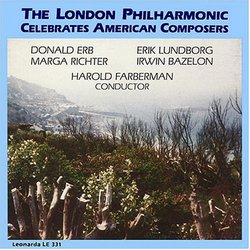| All Artists: Gregg Henegar (solo contrabassoon) Title: The London Philharmonic Celebrates American Composers Members Wishing: 0 Total Copies: 0 Label: Leonarda Productions Original Release Date: 7/6/1990 Release Date: 7/6/1990 Genre: Classical Styles: Forms & Genres, Concertos, Historical Periods, Modern, 20th, & 21st Century, Instruments, Reeds & Winds, Symphonies Number of Discs: 1 SwapaCD Credits: 1 UPC: 019168033126 |
Search - Gregg Henegar (solo contrabassoon) :: The London Philharmonic Celebrates American Composers
 | Gregg Henegar (solo contrabassoon) The London Philharmonic Celebrates American Composers Genre: Classical
Donald Erb: "Concerto for Contrabassoon and Orchestra" (1984) "The concerto's one movement is divided into three sections, each resembling the corresponding movement in a traditional concerto. The first section is a little... more » |
Larger Image |
CD Details
Synopsis
Product Description
Donald Erb: "Concerto for Contrabassoon and Orchestra" (1984) "The concerto's one movement is divided into three sections, each resembling the corresponding movement in a traditional concerto. The first section is a little march-like in character. In this sense it represents a departure from the conventional concerto. This runs directly into a slow 'Night Music' section that presents the solo instrument in a more lyric light. The melodies played by the contrabassoon frequently contain jazzy bends, and the soloist is also called upon to play in the very high register. The last section makes use of the very lowest register of the instrument, which can sound quite earthy. This earthiness, which at times may even seem funny, is in keeping with the historic nature of the scherzo." D.E. * Marga Richter: "Blackberry Vines and Winter Fruit" (1976): "This piece is a one-movement work in four closely related sections. I have attempted to express the feelings engendered by the lonely beauty of a Vermont winter landscape. The following lines from Thoreau provided an added dimension and also the title." M.R./ blackberry vines here and there/ like a streak of blood on the grass/ The flower falls in spring or summer,/ the fruit and leaves fall or wither in autumn,/ but the blushing twigs retain their color throughout/ They are winter fruit. * Erik Lundborg: "Switchback" (1986-88): "In the Rockies, where I grew up, it is impossible to climb to the higher elevations without employing the switchback--a road carved in a zigzag pattern into the side of a mountain, allowing you to look back as you move ahead. A useful way of thinking about this tone poem, which evokes the dramatic spaces of the American West, might be to use the switchback as the central organizing metaphor. 'Switchback' is an homage to the big sky of my youth." E.L. * Irwin Bazelon: "Symphony No. 8 for Strings" (1986): "My first and only work for full string orchestra, this piece is in two movements, the first genuinely slow (sometimes with a fast pulse), and the second, fast (sometimes with a slow pulse). It is both an intensely dramatic work and a long-lined lyrical piece. Occasionally the instruments confront each other as protagonist and antagonist. Certain twelve-tone and jazz passages are in evidence, but are neither strict nor formal." I.B.

 Track Listings (5) - Disc #1
Track Listings (5) - Disc #1